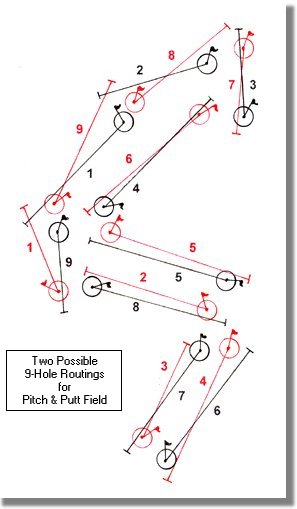
William W. Amick
ASGCA Golf Course Architect
|
|
|
|
|
|
|
|
Pitch and Putt Fields Beginning golfers don’t need an Augusta National…
|
|
Once
upon a time in the far off land called Scotland, there were no
golf courses and no golfers.
Sheep grazed on the dunes between the sea and some of the
towns. Their
shepherds were probably often bored.
At some time, history doesn’t tell us exactly when, on
the grass closely cropped by the sheep those shepherds began to
play a game. So in
places like St. Andrews golf began. To
today its essentials remain the same.
Play starts on each hole at a place now called the tee,
finishes at a cup and between is mostly on short grass or fairway.
With these and minimal playing equipment and some
procedural rules is how any golfer can start the game – long ago
and now. A present
difference is that many courses have elaborate trappings such as
cart paths, edged bunkers, fountains in ponds and plush club
buildings. The
smallest golf courses are called pitch & putt courses.
These have tee shots of limited length.
The greens on many are small and unimaginatively shaped.
Their tees are also usually tiny and the grass quickly gets
worn off them. Mats
at least give a surface that is Fields
are the easiest sites to construct and maintain golf courses on. These permit long runs by equipment in preparing for
grassing, mowing and treating the grass in other needed ways. Open spaces receive maximum sunlight, are most efficient to
irrigate and, if necessary, handiest to install drainage on.
These are all best for growing good grass, so cost-wise the
most efficient situation for a golf course. Sometime
after the “shepherd stage”, greens and tees became fixed in
location, specially constructed and intensively maintained.
These conditions are fully expected today by golfers on all
golf courses. Contrary
to this view, tees and greens don’t really have to have one
permanent location. For
elementary golfer-learning, holes must only have acceptable
starting points, finishing areas around the cups and the grounds
in between. Also
important for each hole is a sufficient separation from the other
holes and from any adjacent activity or facility.
These requirements, however, don’t mean that each tee,
fairway and green always has to be in the same place.
In fact, some advantages occur when their locations can be
varied and flexible. Greens
are the most expensive areas of a golf course to construct.
Tees are next. Fairways
are far less expensive. A
pitch and putt course entirely on a fairway would be a whole lot
cheaper than one including the special building of greens and
tees. As mentioned,
fairways are most economical in a field. If a site is not originally open or partially open then some
clearing, perhaps more earth movement and additional preparations
will be demanded to make the entire site as a fairway.
Once
the grass matures as if the entire site were to be a fairway, the
surface of smaller areas could be more intensely prepared and
maintained. Those
areas would serve initially and for a while as rather simple
greens and tees. Each
should be nearly level or at least have gentle slopes.
These would be selected based on their current surface
condition, not on their underground construction.
But hey remember, we are talking about tees and greens for
pitch and putt courses that beginners and relatively unskilled
golfer will play. Those players couldn’t handle fast putting greens, anyway.
Portions of the field not in use as tees and greens would
already be like fairways and would be the fairways of the holes.
Not
only must the areas for the tees and greens always be carefully
selected for their surface condition, the resulting route of each
hole is also critical. The line of play for each hole must be sufficiently separated
from every other hole and far enough from what else might adjoin
them. This is for
safety from errant golf balls and for a reasonable separation of
the players on each hole. Due
to the shortness of pitch & putt holes, that separation will
require much less total space than for the holes on a regular
course. The
accompanying diagram shows in black one possible routing for nine
holes and in red a possible later routing.
As seen, the holes of these two routings would go in almost
opposite directions. The
players would only have to be informed where each hole is at the
time of their play. Could
these courses be called pitch & putt fields? When an area being used as a tee becomes worn or full of divots, another suitable area of “fairway” could be prepared to become a tee for a while. The same could be done for the greens, if and when those become worn, damaged for any reason or the grass becomes unsuitable. As long as the routing of the holes is satisfactory and the surfaces suitable, areas in any desirable locations of the site or field could simply be prepared and used as greens or tees. No one, beginner or experienced golfer, should think that a pitch & putt field is going to be like a regular golf course or even a commonly seen pitch and putt course. Its purpose is to be a small, inexpensive and comfortable place for beginners to start learning and understanding what golf is about. If its players are “turned on” by what they experience and want to “stay with golf”, after they’d gained some playing competence they could move on to conventional big golf courses. Besides pitch and putt fields will be way ahead of where the shepherds started. Definitely no sheep will be baaing on beginners’ backswings.
|
|
|
| Professional Golf Course Designer - Bill Amick |
| P.O.
Box 1984 Daytona Beach, FL 32115 Telephone (386) 767-1449 |
| amick@iag.net |
